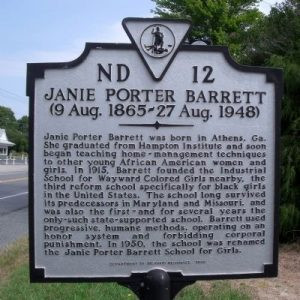In the heart of Hampton, Virginia, stood a beacon of hope and progress: the Locust Street Settlement House. Established in 1890, this institution, modeled after the renowned Hull-House, was the vision of the extraordinary Janie Porter Barrett. Locust Street Settlement House rapidly became a cornerstone of the community, dedicated to enhancing the lives of African American women, children, and families. From innovative child placement programs to comprehensive community development initiatives, Locust Street, under Barrett’s leadership, exemplified the power of social reform and interracial cooperation.
The Vision of Janie Porter Barrett and the Founding of Locust Street
Inspired by Jane Addams’ groundbreaking work at Hull-House in Chicago, Janie Porter Barrett, a prominent African American social welfare activist, founded Locust Street Settlement House. Opening its doors in 1890, Locust Street was strategically located in a predominantly African American neighborhood of Hampton, Virginia. Barrett’s initial efforts were humble yet impactful, starting with weekly gatherings at her home where she mentored young girls. This personal commitment laid the foundation for what would become a significant community institution. By 1902, the growing needs and impact of Barrett’s work led to the construction of a dedicated clubhouse, marking a new chapter for Locust Street Settlement House and its expanding programs.
 Janie Porter Barrett
Janie Porter Barrett
Activities and Community Impact at Locust Street
Locust Street Settlement House was designed to be a multifaceted community hub. Its core mission, as articulated by Janie Porter Barrett, was “to help girls and women to become good homemakers, and to improve the social life of the community.” The settlement house offered a wide array of activities aimed at achieving these goals, including clubs for women and boys, educational lectures, and various social programs. Locust Street was also instrumental in establishing crucial community resources such as a playground and a library, fostering both recreation and intellectual growth within the neighborhood.
According to a description from the Handbook of Settlements in 1911, Locust Street Settlement House’s activities were extensive. The house maintained a library, a supervised playground, and offered classes in essential skills like cooking, sewing, mending, and crafts such as quilt making and embroidery. They also provided instruction in practical skills like home gardening and even poultry raising. Clubs catered to diverse age groups and interests, focusing on social activities, gardening, and athletics. The settlement house also organized entertainments, lectures, and social gatherings, enriching the community’s social fabric. Summer programs were particularly robust, featuring playground activities, excursions, picnics, children’s gardens, and even flower and vegetable shows, demonstrating a commitment to year-round community engagement.
Child Placement and Broader Social Reform
Beyond its community-focused activities in Hampton, Locust Street Settlement House also played a pioneering role in child placement services under Janie Porter Barrett’s guidance. This initiative reflected Barrett’s broader commitment to child welfare, which she further pursued later in her career. Moving beyond Hampton, Barrett, in collaboration with The Virginia State Federation of Colored Women’s Clubs, established the Virginia Industrial School for Colored Girls in 1915 near Richmond. This institution became another testament to her dedication to social reform and her tireless efforts to uplift African American communities.
Janie Porter Barrett’s approach to social reform was notable for its emphasis on interracial cooperation. Her work and the impact of Locust Street Settlement House garnered recognition from prominent white social reformers, including Jane Addams herself. In 1911, Addams hosted a tea party at Hull-House in Chicago in Barrett’s honor, publicly acknowledging and celebrating Barrett’s significant contributions to social welfare and community development. This event highlighted the importance of cross-racial collaboration in addressing social challenges and underscored the national significance of Barrett’s work at Locust Street.
Legacy of Locust Street Settlement House
Locust Street Settlement House stands as a powerful example of the settlement house movement’s impact and the transformative leadership of Janie Porter Barrett. Through its diverse programs and community-focused initiatives, Locust Street significantly improved the lives of African Americans in Hampton, Virginia. Its legacy extends beyond its immediate community, influencing social reform efforts and highlighting the crucial role of African American women in the Progressive Era. For those interested in delving deeper, resources like the Handbook of Settlements and Harvard University Library’s Curiosity Collections offer further insights into the history and enduring impact of Locust Street Settlement House.
For more information, visit:
- Locust Street Settlement, Hampton Va. Curiosity Collections. Harvard University Library.
- Janie Aurora Porter Barrett (August 9, 1865–August 27, 1948). Encyclopedia Virginia.
- Barrett, Janie Porter, Pratt, Caroline D. & Tourtellot, Ida A.. “Community Clubs for Women and Girls” (1912). (2021, November 05). In Encyclopedia Virginia. https://encyclopediavirginia.org/entries/community-clubs-for-women-and-girls-1912.
- This work may also be read through the Internet Archive.
